Articles
Consumer Trends, Clothing, Textiles, and Equipment in the Montreal Area, 1792-18351
Although there is an increasing interest in the family economy among historians studying Quebec, little attention has been paid to the household fabrication of cloth during the colonial period. Similarly, clothing is being studied by a growing number of specialists, especially those in ethnography, but most authors are only beginning to use quantitative methods to develop strong contextual frameworks, which help explain the interrelationship of important historical developments. Factors that tend to be nelected include the rapport between the raw resources of textiles and the finished products, the impact of imported goods on local markets and manufacturing and the relationship between clothing, textiles and other consumer goods. The following analysis of a computerized data bank of 420 000 entries from postmortem inventories provides a basis for studying the subjects mentioned above, as well as for evaluating conclusions based on anecdotal and qualitative sources. Special attention is given in the following discussion to the significant impact of British-manufactured goods on Canadian consumer trends, with particular reference to cloth and clothing in the urban and rural households of different socio-cultural and socio-economic groups in the Montreal region, 1792-1835.
Même s'il existe un intérêt croissant pour l'économie familiale chez les historiens qui étudient le Québec, ceux-ci ont accordé peu d'attention à la fabrication domestique d'étoffes au cours de la période coloniale. Par ailleurs, si les vêtements font l'objet d'études par un nombre croissant de spécialistes, en particulier les ethnographes, la plupart des auteurs commencent seulement maintenant à utiliser des méthodes quantitatives pour créer de solides cadres contextuels aidant à com-prendre les rapports entre des changements historiques importants. On a tendance à négliger certains facteurs, notamment la relation entre les matières premières utilisées pour la fabrication des textiles et les produits finis, les répercussions de l'importation de produits sur les marchés locaux et la fabri-cation, ainsi que le rapport entre les vêtements, les textiles et d'autres produits de consommation. L'analyse suivante d'une base de données informatisées, comportant 420 000 entrées fournies par des inventaires après décès, sert de base à l'étude des sujets mentionnés ci-dessus, ainsi qu'à l'évaluation de conclusions fondées sur des sources anecdotiques et qualitatives. Dans les com-mentaires qui suivent, l'auteur accorde une attention spéciale à l'influence importante des produits britanniques sur les tendances canadiennes en matière de consommation, surtout en ce qui concerne les tissus et les vêtements utilisés dans les foyers urbains et ruraux de différents groupes socio-culturels et socio-économiques de la région de Montréal, de 1792 à 1835.
1 This paper will analyze the impact of British-manufactured goods on consumer trends and habits in Montreal and its surrounding agricultural area, 1792-1835. In order to understand developments elsewhere in Lower Canada, parallels will be drawn between the agricultural districts of Montreal and Quebec City.
2 During the British regime (1760-1840) textiles and clothing formed a substantial part of the value of an estate. They were also a major component of Britain's export trade. By analyzing consumer and production trends in cloth goods it is possible to begin to evaluate the impact of British manufactured goods on the daily habits of Lower Canadians.
3 An analysis of over nine hundred postmortem inventories2 provides a basis for a socio-economic approach to clothing and textile history from which conclusions made by authors using anecdotal and qualitative sources can be evaluated. Given the lack of reliable and comparable census data for the years between 1792 and 1835, colonial historians have been using notarial documents, the richest and most continuous of which is the post-mortem inventory. Taken after the death of a parent, this inventory provides information on the goods of most social and ethnic groups.
4 The absence of studies that establish a rapport between clothing and socio-economic and political factors has left this field of study behind current developments in history. Key variables, such as age and gender, geographical location, socio-economic status and nationalism, have been largely missing from analyses of clothing and textiles. Similarly, the separation of clothing studies from those concerning the evolution of consumer trends in general and of home and industrial textile production in particular, has isolated interrelated developments, which, when considered together, help explain changes occurring in a variety of daily customs.
5 Another problem with many clothing studies is the assumption that it is possible to evaluate how people were dressed by analyzing historical illustrations or by piecing together different parts of a wardrobe found in numerous inventories. These studies tend to gloss over some important questions. First, artists usually portrayed well-dressed people who were rarely representative of all levels of the general population. Second, the majority of colonial inhabitants, especially in rural areas, had only a small amount of clothing. Thus, when the evaluation of a typical wardrobe is based on a qualitative review of illustrations and/or documents, it inflates the amount of clothing an average person possessed.
6 One of the most enduring historical myths in ethnographic and museological circles is the homespun theory which maintains that farming families possessed enough textile equipment to be self-sufficient in cloth production. The significant role played by imported cloth in colonial history has barely been explored. Indeed, the idea that rural families clothed themselves almost entirely in the fabrics of their own making is widespread in both Canadian and American literature.3 Historians on both sides of the border are discovering that the rapport between home manufacture and agriculture is more complex than previously thought.
7 In spite of a number of problems involved in using inventories, most of which have already been identified,4 the existing data bank5 includes a wealth of material about daily activities and consumer patterns during the colonial period. Because the post-mortem inventory provides information concerning domestic textile production, a pervasive occupation performed by women in rural areas, it is an appropriate tool to use in evaluating the role of home manufacture in the fabrication of cloth.
The Context and General Trends
8 Francophones or Canadians whose inventories were taken thirty years or more after the British conquest of New France in 1759 were living in a transitional era.6 In addition to political and economic changes occurring in the late eighteenth and early nineteenth centuries, Canadians were also experiencing modifications in their domestic life.7 Although their households reflected French traditions, their goods were increasingly of British manufacture. By the end of the eighteenth century British merchants largely controlled the wholesale export and import trade, flooding local Canadian markets with British products, especially cloth. This economic domination was further heightened by demographic changes brought about by immigration and a large floating population of Anglophone workers and soldiers.8 Although this arrival of British ideas, goods and immigrants had the most impact on residents of Lower Canadian cities, rural inhabitants also found British manufactured goods, including cloth, too desirable to do without. While they challenged British authority, Canadiens were impressed by Great Britain's military victories, technological innovations and parliamentary traditions. Isolated from France, inundated with British ideas, manufactured goods, and waves of new immigrants, Francophones developed an admiration for many aspects of British culture.9
9 In order to provide a framework for an analysis of clothing and textiles, it is necessary to briefly consider the general picture of colonial possessions. An earlier study of wealth in the Montreal area has shown that since the value of fixed and movable assets outstripped inflation during the early nineteenth century (i.e., 1807-1812), most inhabitants experienced a real increase in their standard of living. One of the results of rising incomes was the acquisition of consumer goods, including luxury goods such as sofas, and rosewood, walnut and mahogany furniture. Although urban merchants, and to a lesser degree their rural counterparts, experienced the greatest increases in their fortunes, rural families also benefited from the existing prosperity.10 With a few important exceptions, notably among urban labouring groups in Quebec City, there appears to be a gradual increase in the percentage of income being spent on consumer goods throughout the colony, especially during the second and third decades of the nineteenth century.11
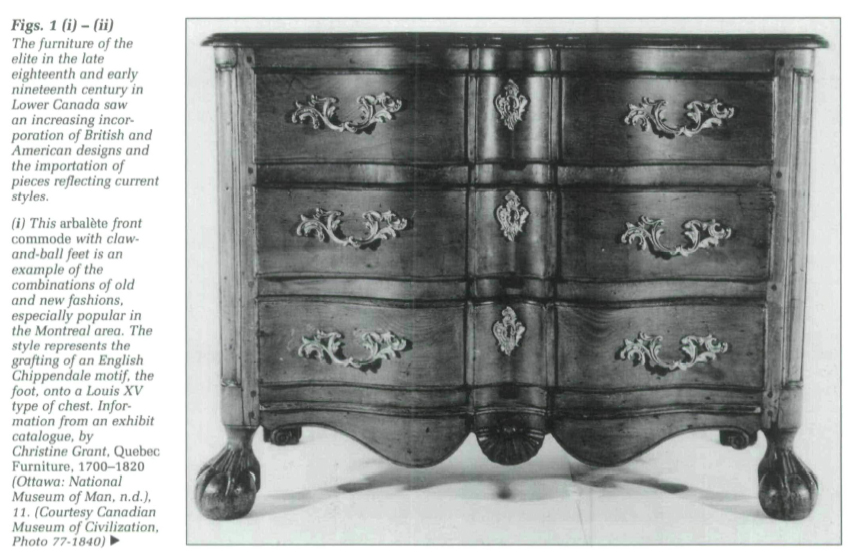 Display large image of Figure 1
Display large image of Figure 1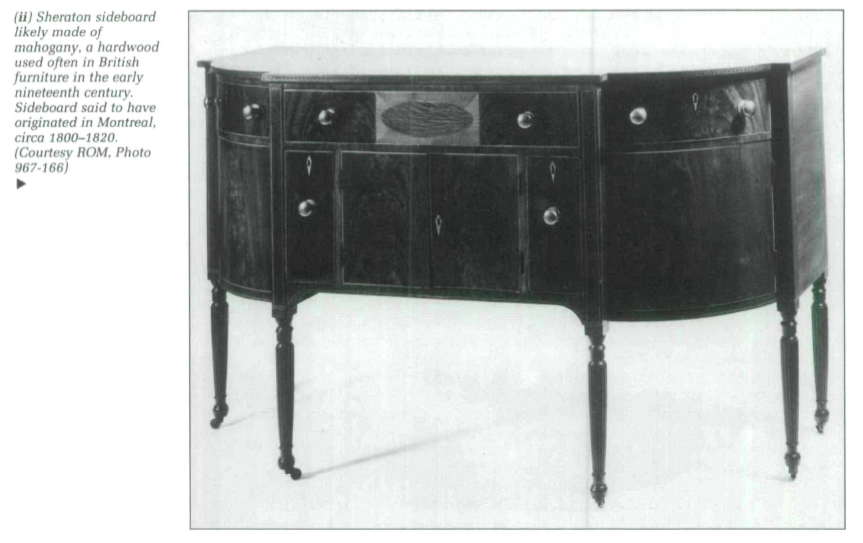 Display large image of Figure 2
Display large image of Figure 210 There is a significant trend, for example, in increasing the comfort level of colonial, and especially, urban homes. Thus, residents had a larger percentage of their movable assets invested in furniture, household linen and bedding, lighting, dishes and personal items than they did previously. While a greater proportion of one's disposable income was diverted to purchase these items, money spent on stoves, tools and farming animals decreased during this period.
11 One must be careful in making such generalizations, as they obscure a number of differences between social groups and urban and rural residents, as well as concealing the evolution of spending habits. An analysis of socio-cultural and geographical factors will help clarify some of these distinctions.
Habitants
12 The French-speaking rural family seemed to fit the cliché that farmers were rich in land and livestock but poor in cash. Agricultural families had considerable amounts of foodstuffs on hand, but most had less money to spend on consumer goods than urban residents.12 Farming families invested less than half the amount the average household devoted to furnishings and in spite of a small increase after 1807, their furniture holdings remained below average during the first part of the nineteenth century. Having little spare specie, the farming population invested a smaller percentage of their incomes in leisure pursuits, furniture, kitchen utensils, heating devices and clothes than other social groups and, as one would expect of rural inhabitants, they raised more livestock.
13 The relatively minor alternations occurring in the home environment suggest that the rural population invested considerably less than other groups in making the interiors of their residences comfortable. The fact that almost ninety-five percent of farming families in the late eighteenth century owned stoves is a clear indication, however, that a measure of comfort was deemed essential, and although they lacked many of the artifacts of domesticity, they more than likely invented games, as well as other means, to help them enjoy long, cold winter days.13
Artisan Households
14 Judging from their inventories, urban artisan houses were more comfortable than those belonging to farming families, but far less affluent than mercantile or professional residences. Thus, artisans had twice as much of their assets in furniture, clothing and kitchen utensils than habitants.
15 Because of the importance of technology to craftsmen, they invested more in tools than other groups. On the whole, however, the percentage of movable goods invested in tools dropped dramatically, from 24 percent in the late eighteenth century to 10.3 percent in the third decade of the nineteenth century. Although difficult to answer with certainty, one wonders if craftsmen were depending more on masters and merchants to furnish them with tools,14 or if, as artisans acquired more wealth, they invested a smaller percentage of it in new machinery.
Merchants and Members of the Liberal Professions
16 Rural and urban merchant families in the areas of both Montreal and Quebec City devoted a greater percentage of their movable assets to household linen and kitchen utensils, as well as to leisure activities, than other social groups.15 Not only merchants, but also notaries, lawyers and doctors, possessed far more musical instruments, games and books than artisans and farmers.
17 The emphasis in the mercantile community on significant artifacts of sociability and domesticity, such as tea caddies and china tea sets, stoves, kitchen utensils and glassware, sofas, card tables and hardwood furniture, pianos, backgammon sets, microscopes, camera obscura, magic lanterns and reading material, suggests that this group was using the home to entertain themselves and their guests in increasingly refined, affluent and occasionally, ostentatious, surroundings. Consider, for example, the stove, this formerly essential and very expensive piece of furniture, which became in the early nineteenth century merely another luxury item for merchant families. No longer, for example, was one stove, traditionally located in the kitchen, used to heat the house. Whereas two-tiered stoves with built-in ovens were now found in the kitchen, as many as ten and even fourteen heating units were located elsewhere in the merchants' large, stone residences.16 Merchants undoubtedly set the trend towards multiple heating units, and were in this respect ahead of professionals.
18 During the late eighteenth and early nineteenth centuries political and economic opportunities opened to notaries and lawyers, providing them with the necessary financial resources to acquire visible indicators of prosperity.17 Like many of their counterparts in New England,18 this upwardly mobile group put more emphasis on appearances, as well as comfort than commercial and labouring groups: professionals had a greater proportion of their personal estates devoted to kitchen utensils, furniture, clothing and personal objects. It is important to note the relative differences between merchants and professionals. For example, whereas the latter devoted a greater percentage of their personal estates to furniture and clothing, the actual value of these goods was far higher in mercantile households.
Clothing, Personal Appearance and Social Status
19 How did clothing fit into the consumer patterns of different social groups and what types and quantities of articles were found in colonial wardrobes? Although some of the following conclusions are predictable, they help form the basis for a better understanding of clothing in Lower Canada, and by so doing, provide insights into societal norms and habits.
20 The desire to portray one's social status was particularly demanding in the hierarchical societies of both the French and British regimes.19 Differences in legal status, socio-cultural and socio-economic distinctions, conceptions and ideologies, socializing institutions, and social relations all form part of the fabric of colonial society. The manifestation of some of these factors can be found in the daily activities and possessions of people. Others are evident in personal appearance (i.e., hair, physical features and body odours), along with keeping abreast of changing fashions and following the rules of etiquette. As mentioned above, contrasts in the ownership of the artifacts of sociability and domesticity, including furniture, musical instruments, books, and houses were some of the obvious status indicators.
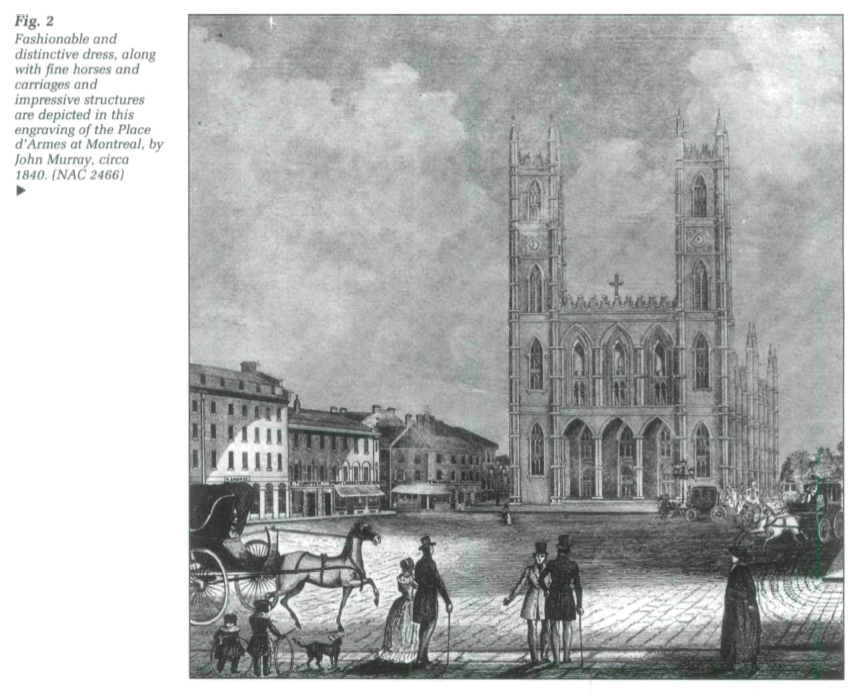 Display large image of Figure 3
Display large image of Figure 321 It is not surprising then that one of the motivating factors behind the acquisition of clothing was also the desire to portray social status. It is evident that certain parts of a wardrobe had special attributes which were meant to distinguish people of different strata from each other. More than physical characteristics or manners, clothing provided individuals with immediate identification.20 Wardrobes gave people a sense of identity and distinctiveness both within and between groups.
22 Indeed, the type of clothing worn by a visitor in Lower Canada immediately told the hosts whether the individual came from the city or a different part of the country.21 Although they probably continued to wear their rustic outfits after returning home to the country, many young rural inhabitants settling in the city asked a tailor to make them a suit à la mode as soon as they could afford it. Prior to the 1830s when the wearing of locally made cloth became an acceptable political gesture due to a boycott of British goods, it was considered unusual or eccentric for urbanites to be seen in the city wearing homespun.22 This is one of the reasons, for example, why Lower Canadian lawyers and priests dressed scrupulously in black with white accessories and avoided wearing the homespun of their rural ancestors.23 Another reason for displaying such distinctive dress was the realization on the part of the members of the elite of the effect their clothing had on their peers and people they considered socially inferior. Finally, as indicated above, there were considerable differences between urban and rural dress, due in part to the large group of farmers whose preference for certain types of clothing provided them with a semblance of homogeneity, while setting them apart from urbanites.
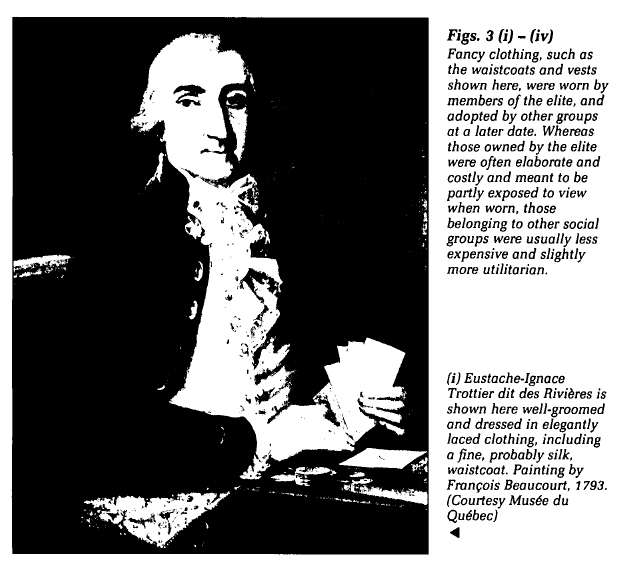 Display large image of Figure 4
Display large image of Figure 4 Display large image of Figure 5
Display large image of Figure 5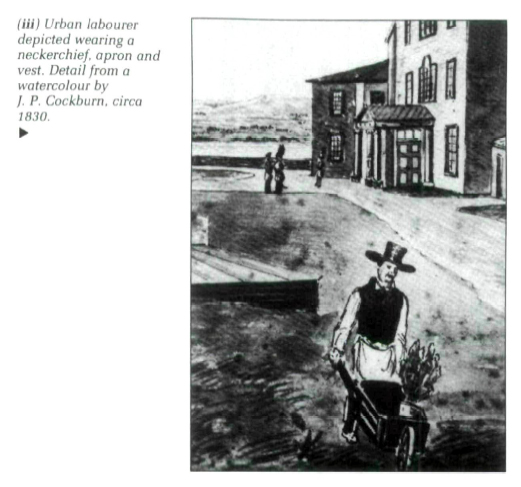 Display large image of Figure 6
Display large image of Figure 6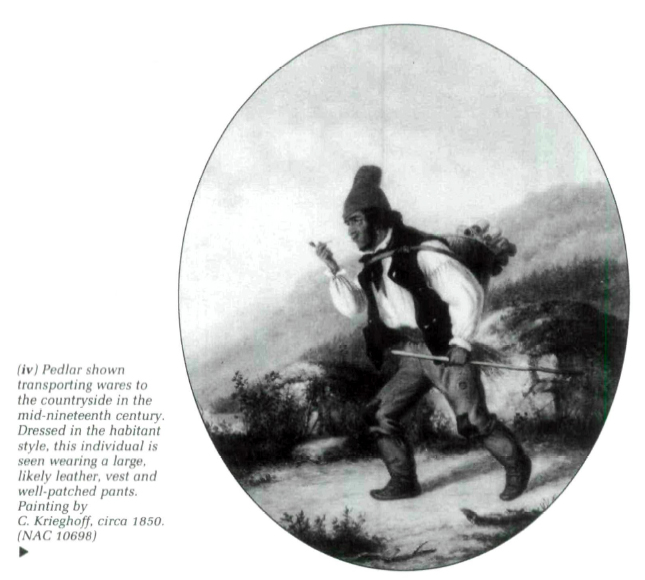 Display large image of Figure 7
Display large image of Figure 7Trend-Setting Professionals and Merchants
23 Since clothing followed similar trends as those previously outlined for other commodities, it is not difficult to imagine that members of the elite had the largest wardrobes. The average percentage of assets devoted to clothes varied according to socio-economic and chronological factors. Thus, although all groups saw their clothing assets rise significantly in the economically prosperous years of 1807-1812 and stabilize between 1820 and 1825, only the wardrobes of the professionals and merchants increased significantly during the early 1830s.
24 These fluctuations seem to be directly related to those occurring in the economy. For example, the reason farming families experienced the most significant increase occurring in clothing ownership in the early 1820s was linked to the strong demand for grain.24 The drop in grain prices in the following decade was accompanied by a similar decline in the habitants' wardrobes.
25 Not only did professionals spend a greater portion of their incomes on clothing, they also appeared to be the most style-conscious. Judging from the percentage of their incomes invested in clothing, urban woodworkers also demonstrated a similar concern for appearances. Merchants often owned more articles than others, but the proportion of movable goods they devoted to their wardrobes was only slightly higher than that of blacksmiths and farmers. The investment of almost twenty percent of their personal estates in clothing made the professionals among the best dressed in the colony, as well as leaders in fashion.
26 Professionals owned the largest percentages of common articles like socks, shoes and shirts and clothing accessories, such as gloves and hats, than other groups. Items typically found in labouring homes, such as locally made coats (capots) and coverlets (courtepointes) were rarely present in professionals' inventories.
27 An analysis of certain items, such as boots and vests, provides insights into the way consumer goods evolved and how they were transferred from the elites to other social groups. Clothing worn by important actors on the historical stage was often exploited by merchants who publicized items such as Wellington and Brunswick boots, in both English and French newspapers, as being the latest styles in footwear.25 It was this type of advertising that succeeded in selling boots, which became popular after the Napoleonic Wars, especially among the style-conscious members of the professions.
28 The fact that clothing trends were often set by members of the upper social strata, is further indicated by the delay in the adoption of articles normally associated with them by labouring groups. For example, as vests made of imported cloth lost their popularity among merchants and professionals, they gained in importance in the wardrobes of labourers' families in both the country and city. Research on the possible existence of a secondhand trade in clothing might help explain the lag in the acquisition of certain items by members of labouring groups.26
29 One of the ways in which the transfer of styles from Great Britain to Lower Canada took place was through the importation of patterns. While tailors, dressmakers and milliners used them to make fancy clothing for urbanites, young women and rural housewives asked their friends and husbands to bring patterns home from the city so that women could reproduce them.27 Similar tendencies were also evident in the evolution of the ownership of hats and coats.
Urban Artisans' Clothing
30 Artisan families invested less of their movable assets in clothing than merchants or professionals, but they owned similar articles. In effect, the concern for comfort and appearances among the families of specialized tradesmen increased at a similar pace as that set by merchants. Thus, in the 1820s, artisans had almost attained the same level of consumption of furniture and clothing as merchants.
31 Urban woodworking families, a relatively high percentage of whom owned dressing gowns (33 percent), corsets (40 percent), shawls (42 percent) and dresses (50 percent), were similar to professionals in their clothing habits. This confirms a trend which is already obvious, that urban fashions were eventually transferred from the upper to the lower social strata.
32 While artisans possessed more common clothing articles and accessories than habitants, they also owned such essential rural items as hooded and short coats (mantelets), and homespun household linen.28 Shared clothing traditions were particularly evident among the families of farmers and artisans, such as blacksmiths who had moved to the city carrying with them a strong concern to preserve old clothing, as well as similar interests in styles and materials as country folk.29
The Habitant's Wardrobe
33 Compared to urbanites, most country people owned limited wardrobes. An analysis of donations provides a portrait of the ideal wardrobes of mature rural couples (forty to fifty years of age) who had given their farms to sons in return for maintaining them during the remainder of their lives.30 According to these notarial documents, the traditional portrait of a well-dressed habitant in his hooded coat, striped pants, colourful woven belt and shoes is supported by the description of items found in these records. However, since only twenty-six belts were listed in the inventories and notations of striped pants were rare, the traditional image represents not the everyday garb of the habitant, but the prosperous farmer in his Sunday best.
34 Similarly, although the woman's ubiquitous short coat or gown, long homespun skirt and moccasins, seen so often in contemporary water-colours and historical accounts, was the primary female outfit, it was often in an advanced state of repair.31 Since women, many of whom possessed sewing needles, also demanded a variety of cloth, they obviously made and repaired a lot of their own clothing.32 In fact, some requested that cloth and wool be provided in place of socks, skirts, short coats and cloaks and headdress. A few women were so conscientious about prolonging the life of their goods that they requested wool to replace the lower parts of used socks.33 Obviously the way people dressed was directly linked to farming: prosperous years gave the rural family the means to purchase imported cloth and French shoes from the local merchant; in lean years they wore their clothes thin and depended on homespun cloth to replace threadbare garments.34
35 When the various economic realities of rural life are considered, they help explain why so few items were listed in inventories. Practices such as constant cleaning, repairing worn-out items and replacing them only when they were no longer useful resulted, by the end of one's life, in a rather threadbare wardrobe.35 Moreover, by the time an individual's inventory was made, clothing was often hardly worth noting.36 In conclusion, portraits of well-dressed country residents, even when complemented by a study of donations, tend to obscure the fact that the wardrobes of most were usually limited and in various states of repair. In seeking to understand the discrepancies between these sources and the inventory data, we must learn more about the economic realities of rural life and the role of homespun in it.
The Homespun Myth: Textile Equipment and Subsistence Farming
36 Did colonial families possess enough equipment to meet all their textile needs? The home manufacture of textiles in Lower Canada satisfied some local, mainly rural needs in clothing and household linen, but it never replaced a long-standing dependence on imported cloth.37
37 Since Montrealers possessed little textile equipment, they obviously did not make much of their own clothing. With the exception of homespun household linen produced in the country and owned by the city's labouring families, urban clothing was made from imported cloth by seamstresses and tailors. Shoes, hats and gloves were imported or made-to-measure by local craftsmen.
38 Even in the countryside where homespun originated, its role was constantly changing. In order to evaluate the degree of textile self-sufficiency it is necessary to know how much equipment existed and the amount of imported cloth present in rural homes. Information available on this subject includes vague impressions and generalizations made by travellers and government officials, idyllic pictures of self-sufficient households and some serious but qualitative evaluations of the question.38
39 Most of these studies seriously under estimate the amount of imported cloth in rural households. As mentioned in the earlier discussion of clothing listed in donations, the demand for imported items remained strong in rural areas. Even in the Quebec City district, which possessed the highest percentage of textile equipment, over fifty percent of important articles of clothing, such as pants, vests, coats and dresses, were made of imported cloth.39
The Rural Family's Equipment
40 The capacity of agricultural families to make their own clothing varied considerably between the eighteenth and nineteenth centuries and from region to region. Although spinning wheels were prevalent during both the French and British regimes, the single most important piece of textile equipment, the loom, was rarer. According to a study of agricultural implements in the Saint-Hyacinthe region, one of the few areas for which a study of eighteenth century data is available, looms were non-existent prior to the period 1778-1782 when a mere four percent of households possessed them. Spinning wheels, however, increased from 36 percent during the decade 1740-1750, to 46 percent by 1782, and to 71 percent for the period 1795-1804.
41 Figures for the latter period correspond with the presence of spinning wheels in the Quebec and Montreal districts. For example, in the Quebec region, rural women owning spinning wheels increased from 63 percent during the late eighteenth century to a high of 80 percent in the early nineteenth century, dropping thereafter to 70 percent in the 1820s. The pattern was similar for the Montreal region; 82 percent of households had spinning wheels in the late eighteenth century: 85 percent owned them in the early nineteenth century, with a decrease to about 70 percent in the early 1820s.
42 Although the frequency of ownership of spinning wheels was similar for all regions, loom ownership differed. In the Quebec region 31 to 47 percent of the rural families in the period 1792-1825 owned looms, while only 18 to 21 percent of the country people in the Montreal region possessed this tool. It is evident that not only had the capacity to produce textiles increased throughout different areas in Lower Canada, but also that the amount produced varied considerably from region to region. More research is needed to discover why settled areas around Quebec and Montreal differed so much in the ownership of looms. Moreover, since most loom-owning households in the Montreal area had on average one loom and only five families possessed more than one, it seems unlikely that farming families were producing quantities of cloth for external markets. A few weavers sold small reserves of wool and linen fabric in local, rural markets but these quantities did not seriously affect the large amounts of imported textiles sold by urban merchants.40
43 Rural domestic textile production may not have had much of an impact on city markets, but it was becoming a significant factor in the household economy of rural areas. The above analysis of cloth-making equipment suggests that the trend towards self-sufficiency in domestic textile production began in the latter part of the eighteenth century and continued to gain strength in the early nineteenth century. The figures of the Saint-Hyacinthe region may not be representative of the entire countryside,41 but the existence of a substantial number of wheels without accompanying looms appears to be indicative of a general situation, that the home production of cloth (i.e., weaving) was insignificant during the seventeenth and most of the eighteenth centuries.
44 Judging from an analysis of movable assets, farming families owning looms appear to have been poorer than those without. In other words, many of those farming families who were making their own wardrobes may have been doing so because they could not afford to buy clothes.42
45 What role does the possession of sheep play in textile production? Consider first the presence of sheep, and second, the relationship between the ownership of flocks and textile equipment. By the late eighteenth century, sheep ownership is a fact of life in the Montreal area: almost ninety percent of habitants own flocks.43 Census returns show that the number of sheep per farm had grown slowly from an average of 2.4 in 1765 to 4.4 in 1784 and 7.5 in 1831.44 These figures are similar to those found in the Quebec city area inventories, which show a fluctuation of between six and nine sheep per farm, between 1792 and 1835. Figures for the Montreal area were much higher: the average number of sheep per owner increased from twelve during the late eighteenth century to seventeen in the early 1820s.
46 What was the relationship between weavers and their primary material, wool? Did most weavers own large flocks? Although sheep are only one of a number of farm animals, their presence was indicative of a rural family's relative wealth; families without sheep were generally poorer than those possessing these animals. Families with looms, however, did not own large flocks. Less than half possessed more than twenty sheep and of the five owners of two or more looms, only two had more than twenty sheep.45 Owners of over twenty sheep, many of whom were probably raising them for their meat, were the most prosperous. Although the lack of looms in many of the households owning the largest flocks suggests that the relationship between textile equipment and sheep was not significant, additional analysis is needed before conclusions can be drawn. For example, since weavers made material for people who provided them with fibre, they did not need to own sheep to be productive.
47 However, because families with looms owned sheep and most rural households that possessed spinning wheels also had flocks,46 they likely used much of the wool in the fabrication of products for their own use, such as knitted items. Moreover, given the poor quality of Canadian wool, it was probably used more for such things as stuffing mattresses and pillows than in producing fibre for the loom.47 The presence of large numbers of spinning wheels in both the Quebec and Montreal regions suggests that much of the wool was being used in knitting.
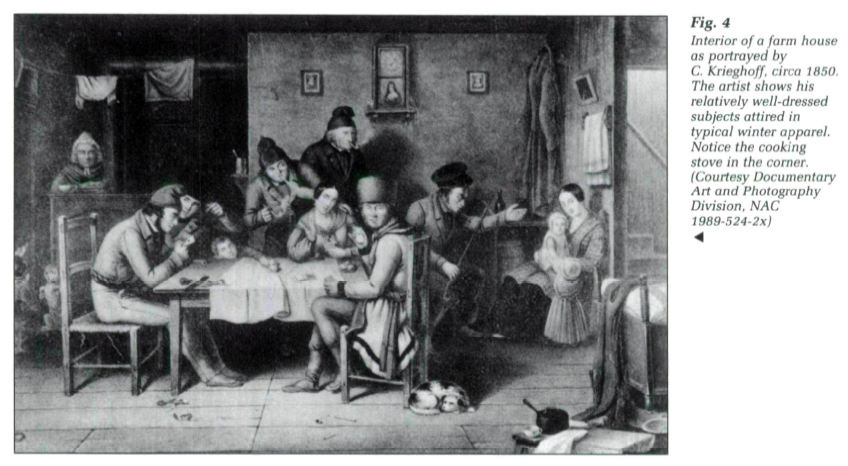 Display large image of Figure 8
Display large image of Figure 8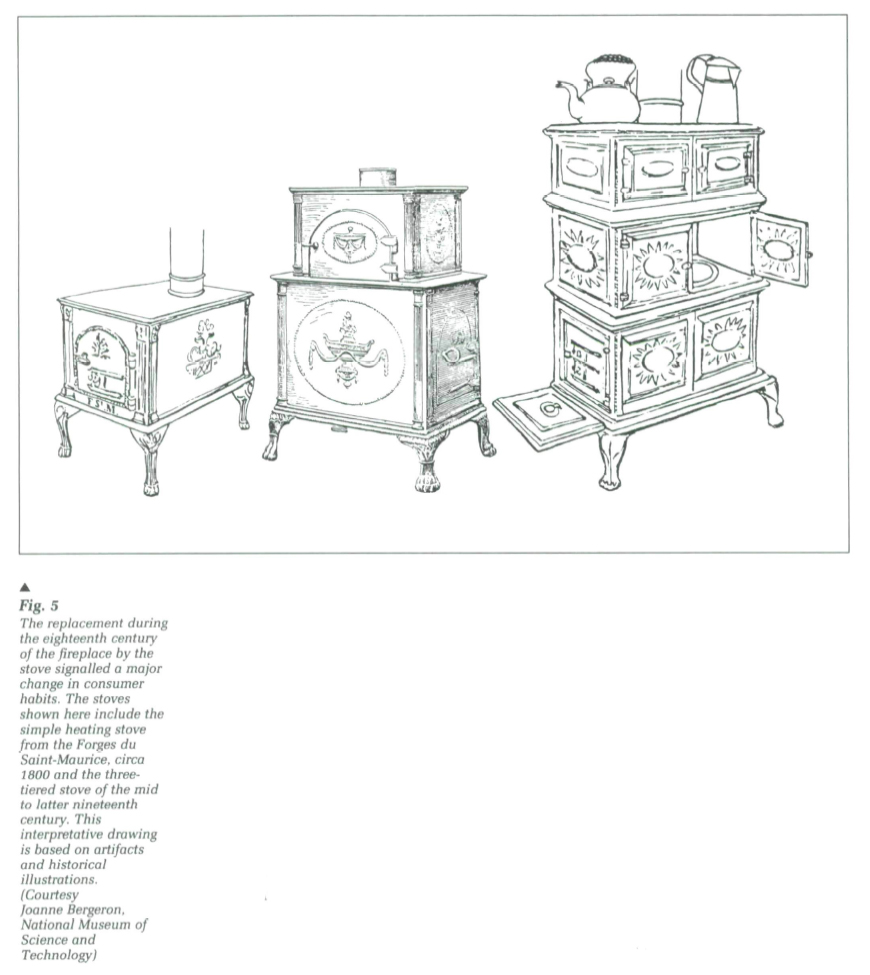 Display large image of Figure 9
Display large image of Figure 948 How many sheep were being kept for wool compared to the number raised for meat is difficult to evaluate, but obviously an important percentage was used for food. Like the situation in parts of the United States, Canadien farmers may have been selling their best sheep for meat.48 Although pork and beef were traditionally the most popular meat in Canada, mutton began to be consumed in larger quantities in the early nineteenth century.49 Were Canadien farming families, like their American counterparts in the eighteenth century, adopting the British taste for lamb?
Conclusion
49 As one of the foremost industrial and imperial nations of the eighteenth and nineteenth centuries, Great Britain exercised a significant influence on consumers. Increased industrial output combined with the spread of British ideas and inexpensive products throughout the western world helped stimulate the modification of consumer behaviour in areas where the British presence was particularly noticeable, such as in the towns of Quebec and Montreal. The distance from urban markets, the self-sufficiency of most rural homes and the farming woman's growing capacity to make homespun clothing, meant that country residents were not so easily influenced by British imported goods as their urban counterparts. In fact, the steady and gradual adoption of the loom as an essential means of home production by Quebec's farming women resulted not only in increased independence from imported clothing, but also it led to the appearance of a distinctive rural dress.
50 Whereas urbanites, including those of French heritage, were especially affected by the influx of British commodities, rural inhabitants did not go untouched. In their admiration for certain British products and customs, Francophones in Lower Canada had developed a taste not only for Wellington boots and mutton, but also for potatoes and a host of consumer goods which had become accessible to common people during the eighteenth century. Other examples include manufactured linen, cups and saucers, and tea.
51 The British influence was so strong that it began to affect daily activities and popular traditions in both the towns and country of Lower Canada. For example, during the early nineteenth century English words began appearing in notarial records written in French, and British symbols were even incorporated into Quebec's rural folk art. A good example of this is the appearance in homespun blankets of designs found in British coverlets which were produced in a large-scale cottage industry in Bolton, a cotton manufacturing town of Lancashire, England. If we compare the eighteenth and nineteenth century Bolton coverlets with those made in Quebec well into the twentieth century, it is clear that although the origins had been forgotten, Canadien weavers had imitated British designs.50
52 The British presence in Lower Canada had become so pervasive that a writer in 1820 described everything in Quebec City as being British. Although an exaggeration, this statement indicates the importance of British influence in Lower Canada. It is not surprising then that even daily drinking habits began to change. Thus, the Canadiens' preference for coffee during the French regime51 underwent some modification during the British regime when tea became a popular beverage among both urban and rural residents in the early nineteenth century.52 The fact that tea had become a common beverage in England in the early eighteenth century and in New England by 1740 and in Lower Canada during the early nineteenth century, suggests both a natural progression in the spread of this custom, as well as a strong British influence in a former French colony.53 Indeed, trends in technology, architecture, furniture, clothing and diet reflected the varying degrees to which British styles had permeated popular culture in French Canada.
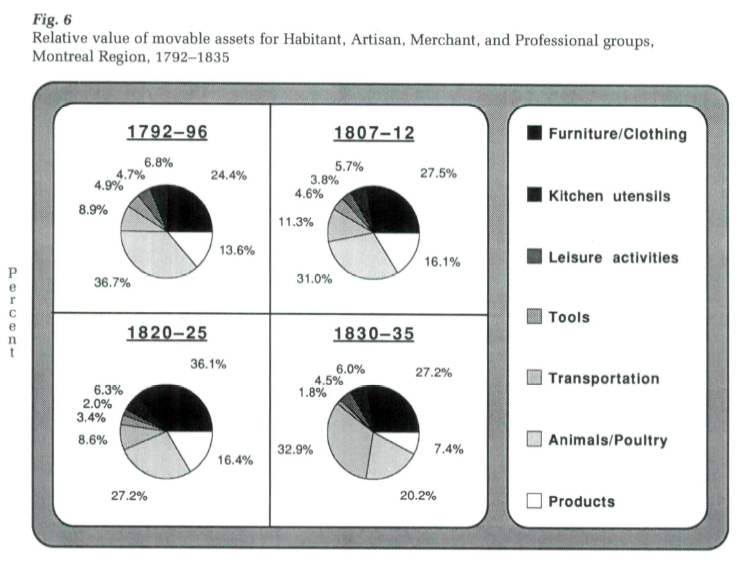 Display large image of Figure 10
Display large image of Figure 10 Display large image of Figure 11
Display large image of Figure 11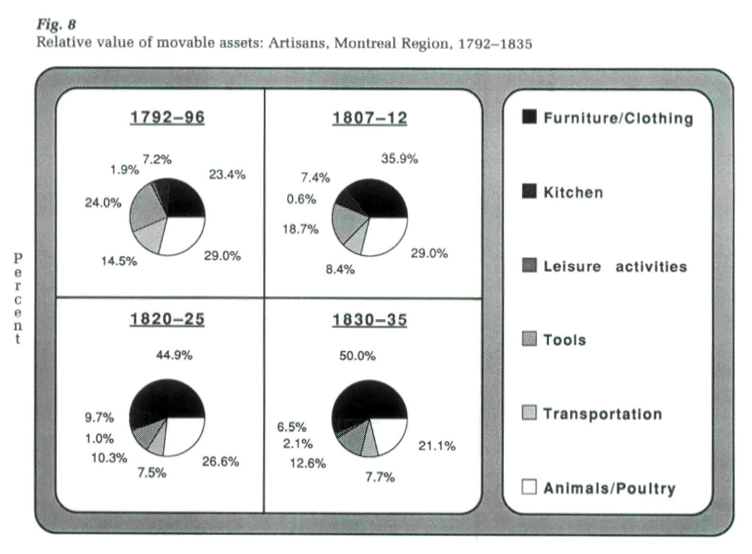 Display large image of Figure 12
Display large image of Figure 12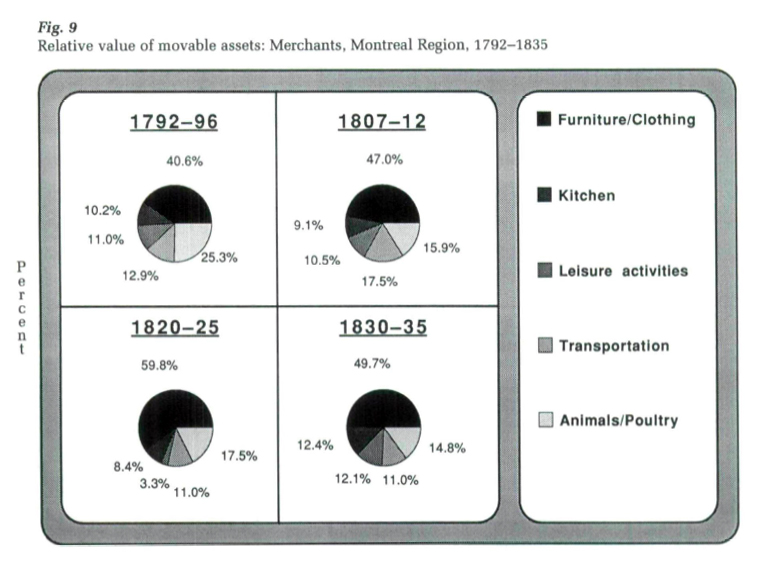 Display large image of Figure 13
Display large image of Figure 13 Display large image of Figure 14
Display large image of Figure 14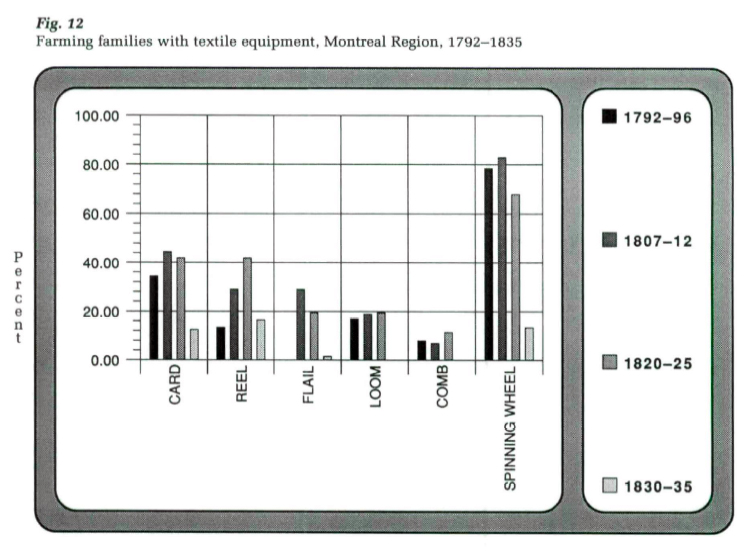 Display large image of Figure 16
Display large image of Figure 16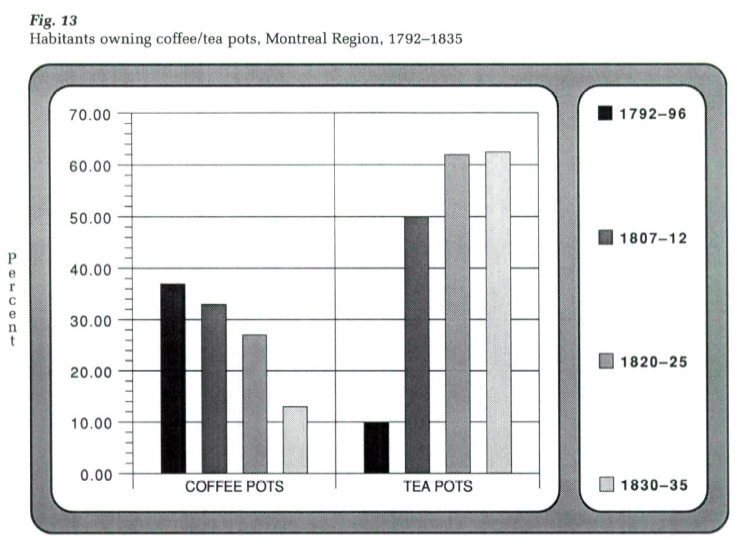 Display large image of Figure 17
Display large image of Figure 17